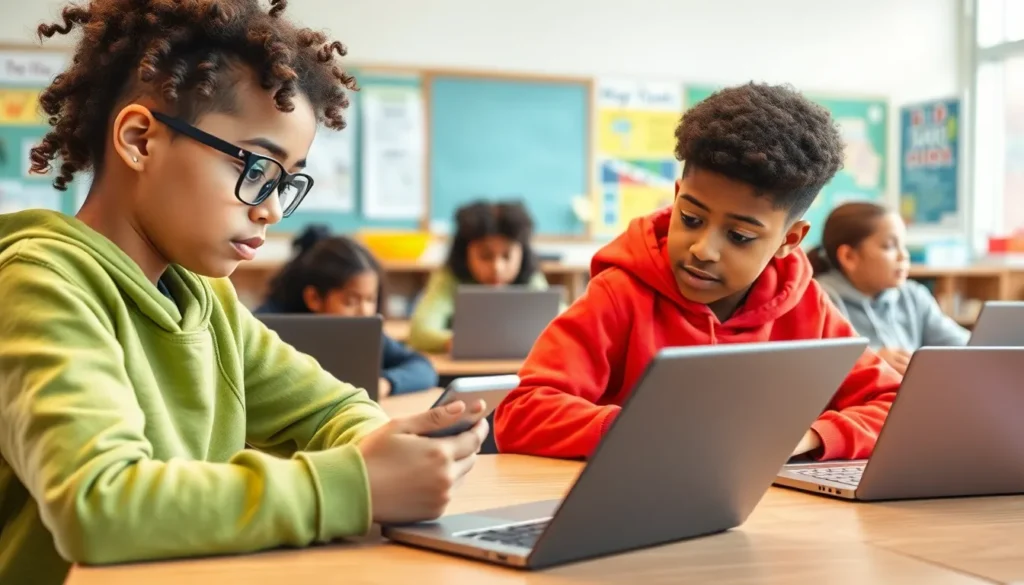In a world where one-size-fits-all solutions often miss the mark, adaptive education systems are shaking things up. Imagine a classroom where each student learns at their own pace, guided by technology that actually gets them. It’s like having a personal trainer for your brain, minus the sweat and the gym membership fees.
Table of Contents
ToggleOverview of Adaptive Education Systems
Adaptive education systems use technology to tailor learning experiences. These systems assess individual student performances and preferences, allowing personalized content delivery. By focusing on specific needs, they eliminate the one-size-fits-all approach commonly seen in traditional classrooms.
Data-driven insights support real-time adjustments, ensuring lessons align with each student’s progress. For example, if a student struggles with math concepts, the system provides targeted resources and exercises. Conversely, if a student excels, it may introduce more challenging material sooner.
Teachers benefit from adaptive education systems as well. They receive valuable analytics about student performance, enabling informed instructional decisions. Increased efficiency results from automated grading and progress tracking, freeing up time for educators to engage more directly with students.
Various platforms contribute to this evolving landscape. Programs like DreamBox Learning and Knewton offer distinct features designed to enhance student engagement. Other systems inspire collaboration among students, fostering an interactive learning environment.
Ultimately, the integration of adaptive education systems leads to improved educational outcomes. Students demonstrate higher motivation and retention rates when learning experiences are personalized. With ongoing advancements in technology and pedagogy, these systems continue to reshape the educational framework for diverse learning environments.
Key Features of Adaptive Education Systems

Adaptive education systems prioritize individualized learning experiences, ensuring that each student receives education tailored to their needs. Technology plays a pivotal role, enabling a shift from traditional methods to personalized approaches.
Personalization
Personalization forms the core of adaptive education systems. Each learner benefits from content that aligns with their specific strengths and areas for improvement. Such a targeted approach encourages engagement and fosters a deeper understanding of material. For example, if a student excels in reading comprehension, the system offers advanced texts to challenge them further. Conversely, students who struggle in math receive foundational resources to build confidence. This customization not only empowers students but also helps them achieve their learning goals more effectively.
Learning Pathways
Learning pathways create unique journeys for each student based on their abilities and progress. Various adaptive platforms utilize algorithms to assess performance continually. These algorithms generate individualized pathways that help students navigate through subjects at their own pace. A student may move quickly through familiar concepts while receiving additional support on challenging topics. This flexibility enables learners to remain motivated, as they often feel a sense of ownership over their educational experiences. Additionally, educators gain insights into student trajectories, allowing them to facilitate more targeted instruction.
Benefits of Adaptive Education Systems
Adaptive education systems offer significant advantages for both students and educators. Personalized learning experiences lead to notable improvements across various academic performance metrics.
Improved Learning Outcomes
Students typically demonstrate enhanced comprehension and retention through targeted learning. Data indicates that personalized instruction correlates with better test scores and overall academic performance. Adaptive systems adjust content based on real-time assessments, ensuring materials match individual skill levels. For instance, students grappling with specific concepts receive immediate support, while others get more advanced challenges. Continuous feedback loops facilitate ongoing adjustments, promoting mastery of subjects. Research shows that learners achieve proficiency faster when encouraged by tailored resources.
Enhanced Engagement
Enhanced engagement occurs as students embrace learning tailored to their interests and needs. Adaptive education systems foster a sense of ownership in the learning process. Students actively participate when lessons resonate with their personal learning styles. Gamified elements within these platforms often increase motivation, enabling students to enjoy their educational journey. The interactive nature of adaptive systems encourages collaboration among peers and creates a vibrant learning community. Educators also witness increased enthusiasm and initiative as engagement levels rise, leading to a more dynamic classroom environment.
Challenges in Implementation
Implementing adaptive education systems presents several challenges that require strategic solutions.
Technological Barriers
Technological barriers significantly impede the adoption of adaptive education systems. Many schools struggle with outdated infrastructure, limiting access to essential tools and resources. Limited internet connectivity in certain areas creates hurdles for students’ engagement and participation. Additionally, integration of new platforms often requires significant training for educators and staff. On top of that, diverse technology proficiency levels among teachers can create inconsistencies in program utilization. Effective training programs and increasing accessibility to technology are crucial for overcoming these obstacles.
Resistance to Change
Resistance to change remains a prominent issue in adopting adaptive education systems. Some educators may feel comfortable with traditional teaching methods, and reluctance to shift from familiar practices can hinder progress. Concerns about the effectiveness and reliability of new systems can foster skepticism among faculty and administration. Addressing these reservations through transparent discussions and evidence-based outcomes may ease tensions. Encouraging a culture of innovation and ongoing professional development promotes a more accepting environment for adaptive strategies.
Future Trends in Adaptive Education Systems
Technological advancements drive the future of adaptive education systems. Artificial intelligence becomes increasingly integrated, enhancing personalized learning experiences. Platforms utilizing AI can analyze vast amounts of data to predict students’ needs more accurately.
Data analytics tools play a critical role in assessing student performance. By gathering real-time insights, these tools enable educators to adjust lesson plans swiftly. Analytics not only highlight areas where students excel but also pinpoint where additional support may be needed.
Personalized learning pathways will become even more prevalent. Custom journeys through educational content focus on individual abilities and skills. As a result, students can progress at their own pace, fostering a deeper understanding of subjects.
Incorporating gamification strategies enhances engagement among learners. Introduced game-like elements motivate students, creating a fun and interactive environment. Increased motivation often leads to higher retention rates, benefiting overall educational outcomes.
Collaboration among educational institutions will expand. Sharing best practices and resources among schools promotes a collective effort towards adaptive education strategies. This approach allows for more comprehensive support, especially in underserved areas with limited resources.
Professional development opportunities for educators will emphasize adaptive teaching methods. Ongoing training ensures teachers remain confident in their ability to implement these innovative systems. Increased teacher support strengthens program efficacy and student success.
Finally, emphasis on equity and accessibility will shape future adaptations in education systems. Ensuring that all students, regardless of background, benefit from personalized learning experiences promotes inclusivity. As adaptive education systems evolve, they must prioritize diverse learning needs to create a fair educational landscape.
Adaptive education systems represent a significant shift in how learning is approached. By personalizing education to meet individual needs they foster an environment where students thrive. This innovative method not only enhances academic performance but also boosts engagement and motivation among learners.
As technology continues to evolve the potential for adaptive education will expand. Embracing these advancements can lead to more dynamic classroom experiences and improved educational outcomes. The focus on equity and accessibility ensures that every student has the opportunity to benefit from tailored learning experiences.
The future of education lies in its ability to adapt and respond to the unique needs of each student paving the way for a more inclusive and effective learning landscape.




